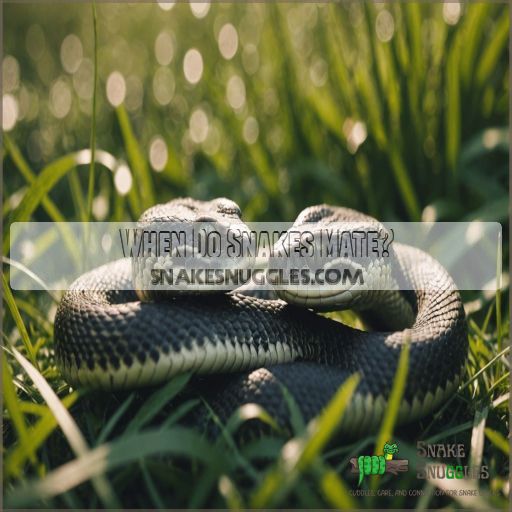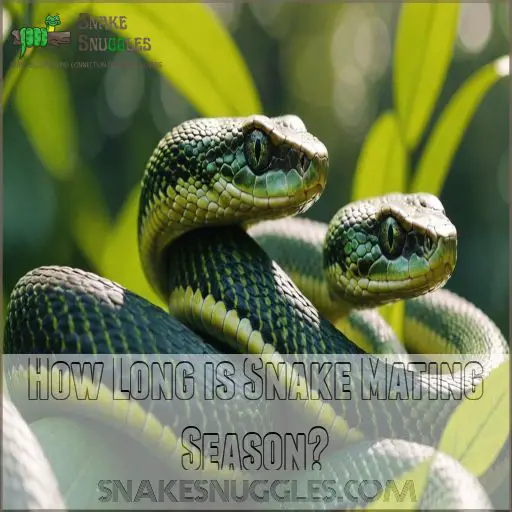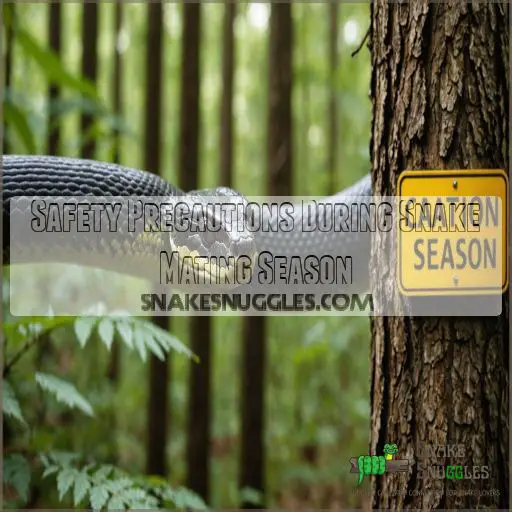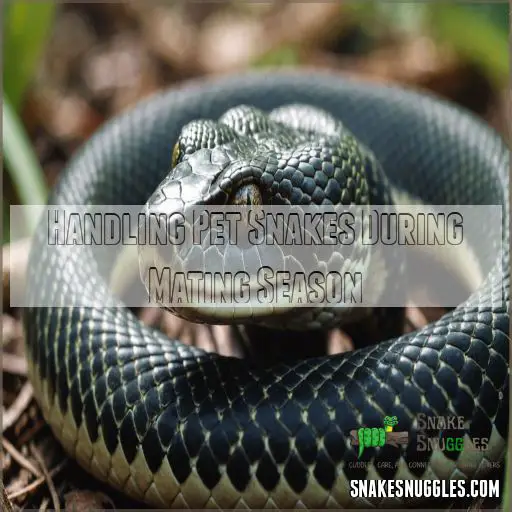This site is supported by our readers. We may earn a commission, at no cost to you, if you purchase through links.
 Wondering when is mating season for snakes? Well, it depends on where they live.
Wondering when is mating season for snakes? Well, it depends on where they live.
In colder climates, snakes wake up from their long winter nap and get busy in spring—typically between March and May.
They’re not just enjoying the warmer weather; they’re looking for love!
Tropical snakes, on the other hand, can mate any time of year, thanks to their consistently warm environment. It’s like having Valentine’s Day whenever they want!
The length and timing of the season vary by species, influenced by factors like temperature, food supply, and location.
Intrigued? Just wait until we unravel more serpentine secrets!
Table Of Contents
- Key Takeaways
- When Do Snakes Mate?
- How Do Snakes Behave During Mating Season?
- How Long is Snake Mating Season?
- How to Care for Snakes During Mating Season
- Safety Precautions During Snake Mating Season
- Handling Pet Snakes During Mating Season
- Frequently Asked Questions (FAQs)
- What months do snakes mate?
- Are snakes aggressive during mating season?
- What time of year do snakes lay eggs?
- What month do snakes come out the most?
- Do snakes mate for life or annually?
- At what time of day do snakes mate?
- How can you identify snake mating behavior?
- How long does the mating process last?
- Do snakes have a breeding season?
- Conclusion
Key Takeaways
- You’ll find most snakes getting frisky in the spring, especially from March to May, as they wake up from their winter hibernation. It’s like nature’s alarm clock goes off, and suddenly these cold-blooded Casanovas are ready for action.
- If you’re in the tropics, don’t be surprised to see snakes playing the dating game year-round. They’ve got a permanent green light for romance, thanks to their consistently warm climate. It’s a reptilian paradise where every day could be Valentine’s Day.
- During mating season, you might witness some snake WWE-style action. Males will wrestle to impress the ladies, showing off their strength and agility. It’s not exactly flowers and chocolates, but hey, whatever works in the snake world.
- You’ll want to keep your eyes peeled and your wits about you during snake mating season. While they’re more focused on finding love than picking fights with humans, it’s still smart to give these amorous reptiles their space. After all, you wouldn’t want to crash their scaly soiree.
When Do Snakes Mate?
If you’re curious about when snakes start thinking about love, the answer lies in understanding their diverse climate preferences.
Whether courting in spring’s chill or cozy tropical rains, snakes have their unique ways of saying, "I choose you!
Snake Mating Season by Climate
When the curtain of winter lifts, awakening snakes from hibernation, the snake mating season begins in colder climates.
Picture a backstage production, where:
- Temperature rises, setting the stage.
- Food availability plays a starring role.
- Species behavior is the plot twist.
Everything aligns for the perfect snake breeding performance. Keep an eye out for these slithery casanovas!
Snake Mating Habits in Tropical Regions
In tropical regions, snakes can mate year-round, thanks to the warm, stable climate.
During courtship, males may engage in elaborate mating dances or physical competitions to impress females.
This constant breeding activity helps guarantee reproductive success, but also raises conservation concerns as snakes face habitat loss and other threats in these areas.
Environmental Factors Affecting Snake Mating
Temperature, food, and shelter play critical roles in the snake mating season. Think of these environmental factors as matchmakers for love-struck serpents.
- Snakes are warm-weather fans—optimal temperatures help successful mating and offspring survival.
- A buffet of available prey means happy, healthy snakes.
- Safe, cozy shelter helps snakes can focus on romance rather than worrying about predators.
How Do Snakes Behave During Mating Season?
During snake mating season, males put on quite a show, engaging in wrestling matches to win the affection of a discerning female, who chooses her partner carefully.
Once they’ve paired up and the business is done, these scaly lovers part ways, never to slither together again.
Male Competition and Aggression
You’ve stepped into the fascinating world of serpentine intimacy, where male snakes square off in epic battles of strength and skill.
It’s like a reptilian soap opera, filled with dominance hierarchies and territorial disputes.
Through ritualized displays and strategic maneuvers, males vie for breeding success.
Female Choice and Mating Behavior
In terms of mating, female snakes call the shots.
They carefully select their partners, often favoring males that display impressive courtship rituals or demonstrate their strength through playful "fights."
This selective process helps the female mate with the most robust and genetically fit suitor, increasing her chances of reproductive success.
Post-Mating Behavior in Snakes
After the female snake makes her choice, there’s a clear-cut "no contact policy" between exes.
Post-mating behavior includes these fascinating moves:
- Separation Patterns: Each slithers off solo.
- Maternal Care: Some females guard eggs; most don’t.
- Nest Selection: Females pick cozy spots.
- Offspring Survival: Young snakes fend for themselves.
Interestingly antisocial, right?
How Long is Snake Mating Season?
Snake mating season varies by species and climate, lasting from a frantic few weeks to several leisurely months.
You’ll be amazed at how nature’s timing blends science and strategy, making even the most reclusive snakes transform into determined Romeos!
Duration of Snake Mating Season by Species
The length of snake mating season can vary greatly by species.
Some snakes, like garter snakes, may mate for just a few weeks in spring.
Meanwhile, tropical species like boas and pythons can reproduce year-round.
Understanding the mating habits of specific snakes is key to providing proper care and avoiding potential conflicts during their amorous activities.
Factors Influencing the Length of Snake Mating Season
Delving into the snake mating season reveals factors acting as nature’s maestro. Classic influencers like temperature and day length impact snakes’ amorous agendas. Food availability plays its part too, much like dinner dates before romance.
Geographic location and species variation lend diversity to this symphony, with some snakes waltzing to unique cues.
Snake encounters and anatomy underscore these behaviors.
Mating Frequency in Snakes
Wondering how often snakes get cozy? Let’s dig in!
Snake reproduction rates vary wildly, depending on the species.
Here’s the scoop:
- Annual or Biennial Mating: Some snakes, like garter snakes, might mate every year, while others only do so biennially.
- Factors Impacting Frequency: Temperature and food availability play major roles.
- Snake Lifespan Influence: Longer-lived species might space out their mating.
Stay ahead of the slithery secrets!
How to Care for Snakes During Mating Season
When the snake circus comes to town — their mating season, that’s — you’ll need to roll out the red carpet of care with a nourishing diet and cozy, enriched habitat.
Don’t forget regular health check-ups, because even cold-blooded romantics need a clean bill of health!
Dietary Needs of Snakes During Mating Season
During mating season, snakes have increased nutritional needs.
Their food preferences may shift, and their appetite grows as they prepare for reproduction.
Provide a varied, protein-rich diet with appropriate dietary supplements to support their health.
Be mindful of their digestion – avoid overfeeding, and monitor their waste to make sure proper nutrient absorption is happening.
Environmental Enrichment for Snakes in Captivity
Your captive snakes need spice in their life during mating season! Enhance their enclosures with environmental enrichment:
- Provide Hiding Spots: Use logs or rocks to mimic natural habitats.
- Stimulate Movement: Introduce branches to encourage climbing.
- Temperature Variations: Create warm and cool zones for comfort.
- Varied Substrates: Experiment with sand, soil, or bark for diversity.
Your snakes will slither happily!
Health Checks and Veterinary Care for Snakes
Enrich your snake’s life while focusing on health checks and veterinary care.
Regular vet visits prevent parasites and make sure your slithering friend is staying healthy.
With snake mating season upon us, make sure your reptile’s care is on point!
Prioritize disease prevention and don’t skimp on the antivenom.
After all, a healthy snake is a happy snake!
Safety Precautions During Snake Mating Season
During snake mating season, staying safe means knowing how to avoid these skilled, slithering Romeos.
It’s smart to learn what to do when you encounter a snake and how to handle emergencies—unless you want to find out the hard way how speedy you’ve really become!
Avoiding Venomous Snakes in the Wild
Steer clear of areas with tall grass or dense brush where venomous snakes may be lurking during mating season.
Keep your distance and avoid sudden movements if you spot a snake.
Stay alert and you’ll safely enjoy the great outdoors.
Safety Tips for Snake Encounters
Spotting venomous snakes can be as thrilling as watching horror movies, but staying safe is key! Consider these lively strategies to prevent snake encounters:
- Watch your step and avoid tall grass.
- Carry a flashlight when walking in the dark.
- Keep Fido on a leash.
- Know your snake facts to separate wiggle from woe by separating fact from fiction.
Stay aware and stay safe!
Emergency Response for Snake Bites
First aid is your best friend if you encounter a snake bite.
Identify venom types quickly to make sure effective antivenom treatment is available.
Symptoms like swelling or dizziness can guide your response.
Keep cool, call emergency contacts, and let professionals handle it.
Handling Pet Snakes During Mating Season
During mating season with your pet snake, you might notice their odd behavior, like extra slithery dances or love-sick flicks of the tongue.
Don’t worry; they aren’t auditioning for a reptilian soap opera—they’re just in the mood for love, and we’ve got tips to help manage these scaly serenades.
Recognizing Mating Behavior in Pet Snakes
Pet snakes can behave quite differently during mating season. Watch for these signs:
- Mating Rituals: More frequent flicking of the tongue and increased activity.
- Body Changes: Subtle shifts in color or size due to hormonal changes.
- Aggression Signs: Temporary irritability or restlessness.
Keep an eye out; even snakes enjoy a little romance, or at least the idea of it!
Tips for Breeding Pet Snakes
Moving from recognizing mating behavior to the actual breeding process, prepare a cozy breeding enclosure for your pet snakes.
Think of it as setting up a snake honeymoon suite!
Make sure you have genetic diversity by selecting compatible pairs.
Monitor snake health closely, and choose ethical breeding practices.
Frequently Asked Questions (FAQs)
What months do snakes mate?
Snakes typically mate in spring and summer, with most species getting amorous from March to August.
In colder areas, it’s spring fever post-hibernation, while tropical residents may slither into action anytime, depending on conditions (Source).
Are snakes aggressive during mating season?
You might think male snakes are like knights, jousting for love during mating season.
Yet, they’re not aggressive toward humans.
They’re more focused on charming a mate than confronting you, so don’t worry about becoming collateral damage.
What time of year do snakes lay eggs?
Snake egg-laying typically occurs in late spring to early summer, following mating season.
You’ll find most species nesting during this time, though tropical snakes may lay eggs year-round like a boa constrictor.
Nature’s clock keeps these slithery parents right on schedule!
What month do snakes come out the most?
Springtime brings the most snake activity, especially in warmer regions.
As temperatures rise, these cold-blooded creatures emerge from winter slumber, ready to bask in the sun and search for mates.
Be extra vigilant during March through May.
Do snakes mate for life or annually?
Unlike some romantic creatures, snakes aren’t lifelong lovebirds.
They’re more like seasonal speed daters, mating annually with different partners.
After their brief rendezvous, these scaly singles slither off, leaving their ex in the dust without a backward glance.
At what time of day do snakes mate?
You’ll find most snakes getting frisky during the day, but it’s not set in stone.
They’re flexible creatures, adapting their love lives to their environment.
Some species might even prefer a moonlit rendezvous!
How can you identify snake mating behavior?
You’ll witness a snake love fest! Look for entwined bodies, "play fights," and hours-long cloaca contact.
Males travel far, competing fiercely.
After mating, they’ll separate quickly.
Watch from a safe distance—don’t interrupt their intimate moments!
How long does the mating process last?
Snake mating can last from an hour to a full day.
The process involves the male aligning his body with the female’s, inserting his hemipene into her cloaca.
After mating, they’ll go their separate ways.
Do snakes have a breeding season?
Believe it or not, snakes do have breeding seasons! It’s a wild world out there.
You’ll find most snakes in colder climates mate in spring after hibernation, while their tropical cousins can breed year-round.
Nature’s timing is impeccable!
Conclusion
Like a spring symphony of scales, snake mating season is a fascinating phenomenon.
Understanding when mating season for snakes occurs is important, whether you’re a snake enthusiast or just curious.
It’ll help you navigate encounters in the wild or care for your scaly pets with confidence.
Now that you’re armed with knowledge about when snakes mate, their behavior, and how to stay safe, you’re ready to appreciate these slithering creatures from a respectful distance.
So, next time you spot a snake, you’ll know if it’s looking for love!












